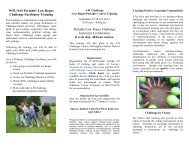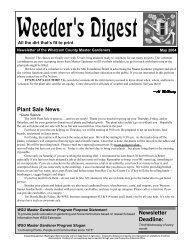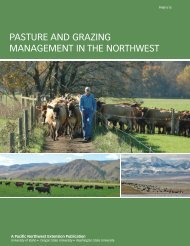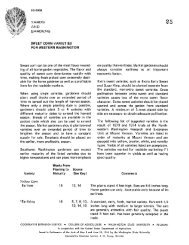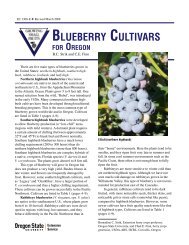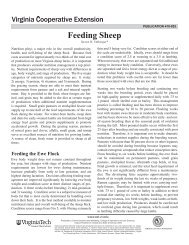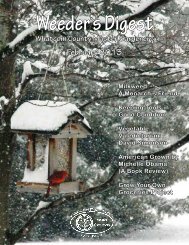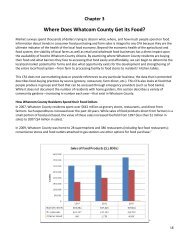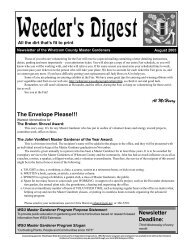Identifying Drosophila suzukii - State of Oregon
Identifying Drosophila suzukii - State of Oregon
Identifying Drosophila suzukii - State of Oregon
- No tags were found...
You also want an ePaper? Increase the reach of your titles
YUMPU automatically turns print PDFs into web optimized ePapers that Google loves.
<strong>Identifying</strong> <strong>Drosophila</strong> <strong>suzukii</strong>Version from June 2, 2010<strong>Oregon</strong> Department <strong>of</strong> AgricultureJosh Vlachjvlach@oda.state.or.usThoraxAntennaeWingAristaAbdomenHaltereOvipositor<strong>Drosophila</strong> <strong>suzukii</strong> femaleIMPORTANT: This is a dichotomous key. Dichotomous keys onlywork properly when specimens are worked through the key step by step.Characters cannot be taken from the key and used independently. Doingso will result in misidentifications.
1. a. Two wings and two halteres (Figure 1a)…………………….. 2b. Either four OR no wings. No halteres.………………Not a flyFigure 1aHaltere2. a. Red eyes…………………………………...…………………..3b. Eyes other than red……………………...….……not D. <strong>suzukii</strong>
3. a. Wings clear (Figure 3a1) or with a dark spot near the end<strong>of</strong> the leading edge <strong>of</strong> the wing on first vein (Figure 3a2)…….…4b. Wings with bands, multiple spots, with a crossvein with adarkened “cloudy” area around it (Figure 3b1), or a spot at the tip<strong>of</strong> the wing on second vein (Figure 3b2)……..……..not D. <strong>suzukii</strong>Figure 3a1clear wingFigure 3b1“cloudy”wingvein
1 st veinFigure 3a2D. <strong>suzukii</strong>male2 md vein1 st vein2 md veinFigure 3b2Scaptomyzaterminalismale
4. a. Short, stubby antennae with branched arista (Figures 4a)…………………………………………………….……………... 5b. Long antennae or short stubby antennae with an unbranchedarista (Figure 4b) ………………….……………..…not D. <strong>suzukii</strong>Figure 4aFigure 4b5. a. Length under 4mm (~1/8”)………………….…………….…..6b. Length over 4mm …………………….…………not D. <strong>suzukii</strong>
6. a. With single dark spot near wing tip……………….…………………………..………………….….....D. <strong>suzukii</strong> male (Figure 6a)b. Without spot near wing tip……….………………...……..…..7Figure 6a:D. <strong>suzukii</strong> male<strong>Drosophila</strong> <strong>suzukii</strong> male character summary:1. Light yellow or brown fly with red eyes.2. Dark spot on the leading edge <strong>of</strong> the wing near the tip, centeredon the first major wing vein3. Markings consist <strong>of</strong> bands at the ends <strong>of</strong> abdominal segments.These bands are unbroken.4. Front feet with two combs each. Combs with 3 to six teeth.Teeth <strong>of</strong> combs parallel to the length <strong>of</strong> the foot.
7. a. Without combs on feet (Figure 7a) ……………..…... 8 (females)b. With one (Figure 7b1) or more (Figure 7b2) combs on frontfeet or with male genitalia (Figure 7b3)…………10 (males)Figure 7aFigure 7b1Figure 7b2Figure 7b3Male genitalia
8. a. Large sclerotized (hard, shiny and dark), ovipositor with strongserrations or teeth (saw-like edge when fully exposed)(Figure 8a)..………………………………………………………9b. Small s<strong>of</strong>t ovipositor sometimes with weak serrations or teeth(Figure 8b). ……..……………………………………….…NOPEFigure 8aFigure 8b
9. a. Teeth on ovipositor much darker than the rest <strong>of</strong> ovipositor(Figure 9a1, 9a2).The body is free <strong>of</strong> stripes, spots, or patterns except for completedark bands (no breaks) at the end <strong>of</strong> abdominal segments (Figures9a3, 9a4). The last segment is sometimes all dark brown.…………………………….……….….....D. <strong>suzukii</strong> female (Figure 9a5)b. Teeth on ovipositor the same color as the rest <strong>of</strong> the ovipositor (atmost slightly darker) (Figure 9b1, 9b2)OR body with stripes, spots, or patterns other than above (Figure 9b3)including a break in the center <strong>of</strong> the abdominal bands (Figure 9b4)………………………………………………….………………….NOPEFigure 9a2D. <strong>suzukii</strong>Figure 9a1D. <strong>suzukii</strong>Figure 9b1Figure 9b2Note: the female ovipositor consists<strong>of</strong> two halves, visible here
Figure 9a3, D. <strong>suzukii</strong>Figure 9b3D. buskiiFigure 9a4:D. <strong>suzukii</strong> femaleFigure 9b4
Figure 9a5:D. <strong>suzukii</strong> female<strong>Drosophila</strong> <strong>suzukii</strong> female character summary:1. Light yellow or brown fly with red eyes.2. Large, hardened, saw-like ovipositor with dark teeth.3. Markings consist <strong>of</strong> bands at the ends <strong>of</strong> abdominal segments.These bands are unbroken.4. No dark areas around wing veins.5. No combs on front feet.6. Smaller than 1/8” or 4mm.
10. Males.a. Front feet with a comb on first and second segments (Figure 10a)..………………………………………………………………………11b. Front feet with 1 (Figure 10b), three, or more combs on front feet………………………………………………….…....not D. <strong>suzukii</strong>4325Figure 10aD. <strong>suzukii</strong>154321Figure 10b: D. melanogaster
11. a. Front feet with teeth <strong>of</strong> combs on first and second segmentsparallel to the length <strong>of</strong> the foot and combs with 3 to 6 “teeth”(Figure 11a1),End <strong>of</strong> abdominal bands with a continuous dark band and lastsegment <strong>of</strong>ten dark brown, otherwise the body and legs do nothave notable markings……………D. <strong>suzukii</strong> male (Figure 11a2)(These are rarely observed. Specimens keying here should be verified by anEntomologist).b. Front feet with teeth <strong>of</strong> combs on front feet perpendicular to thelength <strong>of</strong> the feet or with more than 6 “teeth” (Figure 11b)OR body with patterns other than above (bands on body, splitbands on abdomen, etc.)…………………………...not D. <strong>suzukii</strong>Figure 11a1. Teeth parallel to foot, D. <strong>suzukii</strong> maleFigure 11b. Teeth perpendicular to foot
Figure 11a2. D. <strong>suzukii</strong> “spotless” male<strong>Drosophila</strong> <strong>suzukii</strong> “spotless” male character summary:1. Light yellow or brown fly with red eyes.2. Front feet with two combs each. Combs with 3 to six teeth.Teeth parallel to the length <strong>of</strong> the foot.3. Markings consist <strong>of</strong> bands at the ends <strong>of</strong> abdominal segments.These bands are unbroken.4. No dark areas around wing veins.5. Smaller than 1/8” or 4mm.NOTE: All images have been taken from materials produced by MartinHauser <strong>of</strong> CDFA unless otherwise noted.



